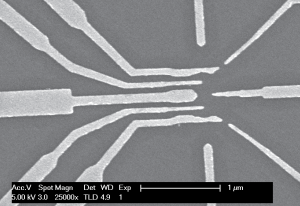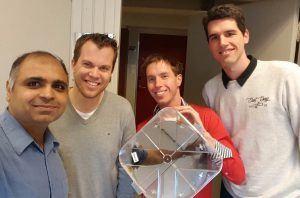Our group operates at the forefront of scientific research of mesoscopic physics and nanodevices, with a focus on controlling electronic spins confined in semiconductor quantum dots, the main concepts and projects of which we list below. Besides this, we also invite you to read up on our past excursions into the physics of graphene, complex oxide interfaces and Lieven’s background of NMR qubits. A full list of our publications can be found here.
To guide you through previous and ongoing spin qubit projects, we first introduce several key concepts:

The workhorse material for studying mesoscopic and nano-scale physics in semiconductor devices has always been (aluminium) gallium arsenide, a material that can be grown almost devoid of atomic defects.
Apart from forming a platform for studies of (two-dimensional) electronic physics such as the quantum Hall effect, it has a long history in Delft as also allowing for the realization of gate-defined (one-dimensional) channels and (zero-dimensional) quantum dots. All the basic ingredients of spin qubit control have been first shown on this platform.
Over the last couple of years, silicon substrates have also been shown to provide a feasible platform for the formation of quantum dots. The silicon platforms show great promise, not just because of a compatibility with industrial-grade nanofabrication processes and the avenue for scaling that this provides, but also because of greatly extended electron spin coherence times.
Having added previously wild and uncontrolled electrons in semiconductors to the petting zoo list of tamed quantum systems does not mean our work is done. In line with our QuTech roadmap goal of fault-tolerant quantum computing, we have started to seriously address the key issue of scaling.
Many projects and collaborations we embark on today, including those with TNO and Intel Corporation, but also with our colleagues at the Veldhorstlab and Scapuccilab, are indeed focussed on demonstrating key components required to scale up our systems in the pursuit of full-blown quantum computing.

A more novel implementation of our quantum dot systems lies in the realization of artificial model systems. Quantum dot arrays behave very similar to the lattices of interacting electrons that can be found in poorly-understood systems such as high-Tc superconductors or spin liquids. We would like to invite our experimental and theoretical colleagues to envision such quantum simulation experiments using quantum dots, in an attempt at understanding the physics of strongly-correlated quantum systems, systems with the potential for novel and useful electrical and magnetic properties.